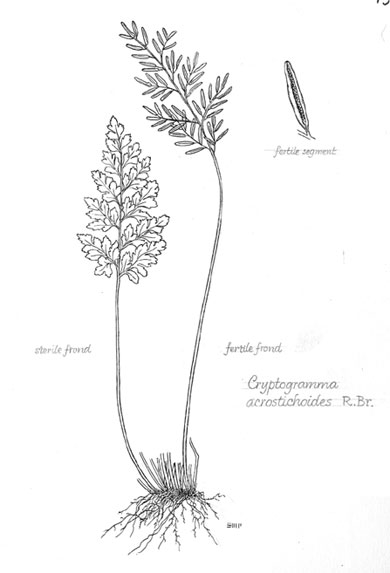|
Hardy Fern Home C. acrostichoides resources
All Ferns � Pteridaceae �� Cryptogramma
�Other Genera
|
| Cryptogramma acrostichoides | ||
Parsley fern, American rock brake | ||
|
Etymology
Acrostichoides is the word that means resembling the Acrostichum, a tropical fern, where the sori completely cover the undersurface.
Description
Rhizome: short-creeping, branching, covered with old stipe bases, scales bicolored, dense, broadly lanceolate to linear.
Frond: 25 cm high by 4 cm wide, evergreen, and persistent after withering the following spring, dimorphic, the sterile fronds much shorter than the fertile ones, blade/stipe ratio: 1:3. Stipe: brown at base, then straw-colored, then green, scales at base and cylindrical hairs scattered along the upper groove of the stipe and rachis, continuing to the costa, vascular bundles: 2. Blade: 2-pinnate fertile fronds, the sterile sometimes more, deltate to ovate, herbaceous, bright green, hydathodes sunken beneath the surface. Pinnae: 5 to 6 pair, lanceolate, 1-2 cm, the fertile ones contracted; margins entire; veins free. Sori: elongate, submarginal, indusium: false, strongly enrolled, sporangia: yellow, maturity: summer. Culture
Habitat: Noncalcareous cliff crevices, rock outcrops, and talus, often in relatively dry habitats, typically montane .
Distribution: western and northern North America at higher altitudes or latitudes, northern China, Mongolia, Siberia.
Hardy to -40�C, USDA Zone 2, requires a cool summer.
Synonyms
Cryptogramma crispa (Linnaeus) R. Brown ex Hooker subsp. acrostichoides (R. Brown) Hult�n Cryptogramma crispa var. acrostichoides (R. Brown) C. B. Clarke |
|
|

Cryptogramma acrostichoides. a) short sterile and long fertile fronds, b) fertile pinnule. �Illustration by V. Fulford from Ferns and Fern Allies of Canada, William J. Cody and Donald M. Britton, 1989, � Agriculture Canada, used with permission. |
